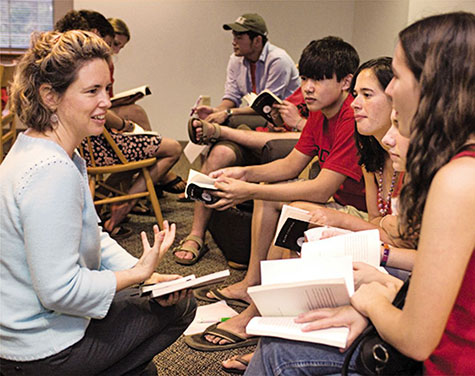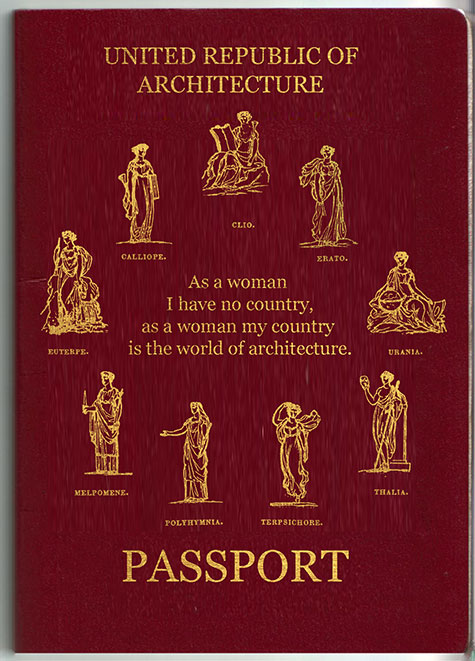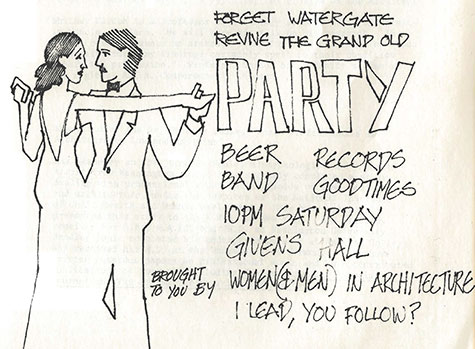
In 1972, as a graduate architecture student at Washington University in St. Louis, Hannah Roth was part of a small group of women who began meeting Sunday evenings to discuss the challenges of entering a largely male profession.
“In my master’s class of 32 people, I was the only woman,” said Roth, a former vice-president at McCarthy Building Companies Inc., and lecturer in the Sam Fox School of Design & Visual Arts. “There were no role models, no mentors, in our immediate sphere. There was no one to show us how to be professional women.”
And so in 1974, with the encouragement of then-dean of architecture Constantine Michaelides, Roth chaired “Women in Architecture,” a groundbreaking symposium that drew more than 450 students, scholars and practitioners from around the country.
On Nov. 7-9, the Sam Fox School will mark the symposium’s 40th anniversary with “Women in Architecture 1974 | 2014,” a three-day event that celebrates the achievements of the last four decades but also underscores the need for continuing conversation — and action.
Work to do
“In some ways we’ve made progress,” said Heather Woofter, associate professor of architecture, chair of Graduate Architecture and, like Roth, an organizer of the symposium. “But there’s definitely still work to do.”
For example, according to the National Architectural Accrediting Board, in 2012-13 (the most recent year for which figures are available), female students comprised 43 percent of enrollment in accredited programs — still not parity, but a significant improvement. On the other hand, according to the Bureau of Labor Statistics, the number of women working as architects has stalled at around 25 percent.
“There is a gap between architectural education and architectural practice,” Woofter said. “In school, there’s an emphasis on collaboration and a culture of research and critical thinking.”
But, she said, the design studio is a unique, high-pressure environment. “It can be very demanding, very disciplined,” Woofter said.

And yet the challenges of studio culture are not merely those of work/life balance, Woofter said. “There are many ambitious, driven women who want to have an impact on the environment, who want to have an impact on design — and who are willing to put in the hours.
“The strength of woman designers is essential to the success of our profession,” Woofter said. “But this is not just about women vs. men. It’s about lifestyle and choices and inclusion. Today we’ve become a more communicative society. The projects we work on are more complex, more interdisciplinary, more collaborative.
“To advance critical thinking, we need to take other viewpoints into account,” she said. “Other voices matter.”
Framing the conversation
For Roth, looking back over her career, 1974 can seem like a different world. Yet obstacles and institutional barriers still exist — and can be maddeningly difficult to uproot.
“Overt harassment is easier to deal with,” Roth said. “It’s easier to identify. And demographics have resolved many issues. Today, when you look at the big firms, entry and mid-level staff are about equal. Women have responsibility.
“But when you look at the top level,” Roth added, “at the CEOs and executive steering committees … Those in power don’t want to relinquish it.”

Such discrepancies are certain to be examined during “Women in Design Practice,” one of the symposium’s four panel discussions. Other panels will explore the state of architectural education; the impact of feminist discourse; and the experiences of architects from minority groups and the LGBT community.
“We’ve been able to frame the conversation in a way that’s both retrospective and forward-thinking,” said Grace Davis, a senior in architecture and one of several student organizers. “How much has changed since 1974, and how do we see ourselves moving forward?”
Davis points out that in some ways, the conversation has already begun. “People are connecting via social media, on our Facebook and Twitter pages,” she said. “Authors, critics, curators, people at national firms … the general reaction has been ‘Thank you for doing this.’
“It’s taught me to not be afraid of asking bold, provocative questions,” Davis said. “Why does architecture continue to have such a large gender gap?
“And what does it mean for our generation of young professionals?”

Events and registration
“Women in Architecture 1974 | 2014” will begin at 6:30 p.m. Friday, Nov. 7, with a keynote address by Nasrine Seraji, founding partner of Atelier Seraji, Architects and Partners in Paris and dean of the Ecole Nationale Supérieure d’Architecture Paris-Malaquais. The lecture takes place in Steinberg Hall. A reception will precede the talk at 5:30 p.m. in the Mildred Lane Kemper Art Museum.
Panel discussions will take place Saturday, Nov. 8, followed by a series of professional workshops on Sunday, Nov. 9. Panels will include: “Feminisms: Now and Then,” “Women in Architectural Education,” “Crossing Boundaries” and “Women in Design Practice.”
In conjunction with the event, students have curated “Women in the Design World: Work in Progress.” The exhibition, on view in Steinberg Gallery Nov. 2-10, features work by female faculty and alumni as well as artifacts and videos from the 1974 symposium and a 150-year timeline of women in design.
Women in Architecture: 1974 | 2014 is sponsored by the Sam Fox School of Design & Visual Arts. The symposium is supported by Arcturis, Universal Fibers, the AIA Scholarship Fund, DigiReprographics USA, Inc., Washington University Libraries, and a Diversity and Inclusion Grant from the Office of the Provost.
All events are free and open to the public, but registration is required for meals and select events. For a complete schedule or to register, visit samfoxschool.wustl.edu/wia.
